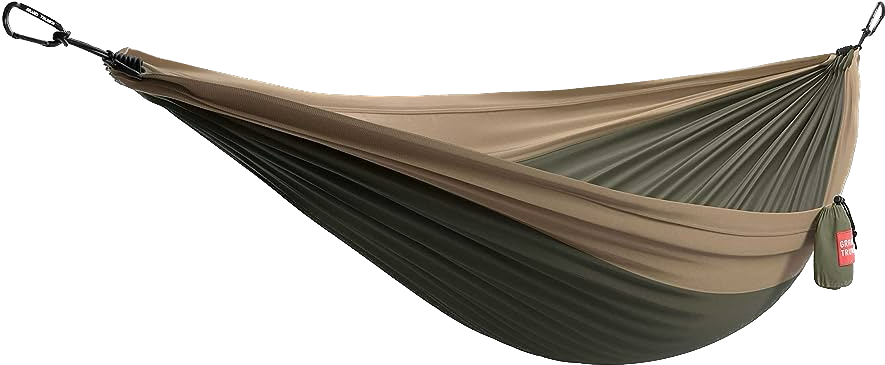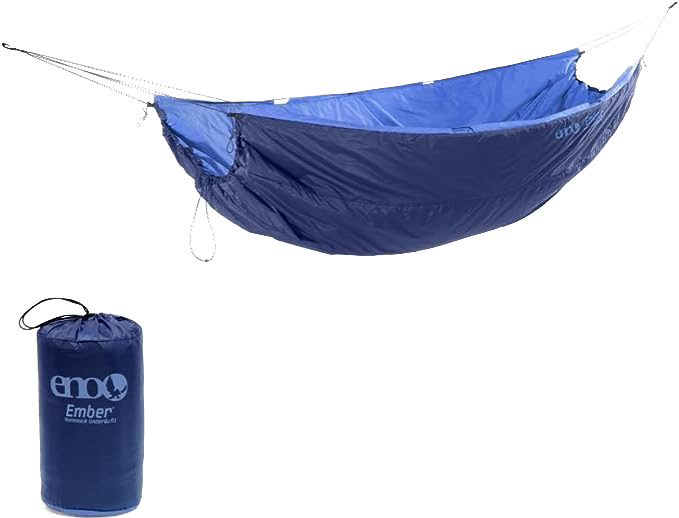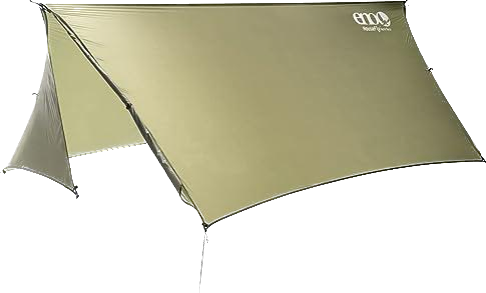If you’ve ever lounged in a hammock, you know how great it is to lay around – it’s the perfect combination of comfort and relaxation. However, when the mosquitoes descend upon your setup, that moment can quickly become a frantic swatting frenzy.
The question is, what can someone do against these tiny biting insects? In this post, you will find various options for protecting yourself from insects while lounging in a relaxing hammock surrounded by nature’s gentle breeze!
Short Summary
- Lightweight bug tarps, permethrin-treated hammocks, natural repellents and essential oils, and hammock accessories offer viable alternatives to traditional mosquito nets.
- Bug protection is key for a comfortable outdoor experience when using a hammock.
- Consider factors such as weight, packability & ease of setup when choosing an alternative to the mosquito net.
Factors to Consider When Choosing a Mosquito Net Alternative for Hammocks

With hammock camping becoming more popular, mosquito and bug protection has evolved and now offers several solutions. A mosquito net is a go-to solution for the typical hammock, but there are different alternatives when it comes to fighting off bugs and mosquitoes.
When it comes to finding the right solution for you, there are a few factors to consider. Some of these include the following:
- Size and Compatibility
- Ease of Setup
- Portability
- Breathability and Visibility
- Material and Durability
- Versatility
- Price
- Use/Activity (Backyard Hammocking vs Hammock Camping)
Overview of bug net alternatives for hammocks
There is a wide selection of alternatives to bug nets available for hammocks, each with its own unique benefits.
For example, lightweight tarps are convenient and versatile in setup while permethrin-treated fabric provides effective protection from mosquitoes and other insects.
Natural repellents like citronella or lemongrass can also be used to keep away bugs that may try to intrude upon your relaxation time.
There are several accessories designed specifically for providing additional bug protection such as integrated netting enclosures which attach directly to the hammock’s frame or attached screen rooms that encase it entirely.
Given all these options, we provided a table below to help you select which solution is best for you. Additionally, we’ve dived into a few solutions to better explain the pros/cons and our overall recommendation.
| Mosquito Protection Alternatives for Hammocks | Ease of Setup | Portability | Price | Customer Reviews | Average | Best for | Description |
|---|---|---|---|---|---|---|---|
| Insect Repellent Clothing | 9 | 9 | 7 | 7 | 7.57 | Camping, Hiking | Wear clothing treated with insect repellent. |
| Mosquito Repellent Bracelets or Bands | 9 | 9 | 6 | 7 | 6.86 | General Use, Outdoor Activities | Wear mosquito repellent bracelets or bands. |
| Citronella Candles or Torches | 9 | 8 | 5 | 6 | 6.00 | Backyards, Patios, Outdoor Gatherings | Place citronella candles or torches around the hammock area. |
| Mosquito Coil | 7 | 8 | 4 | 6 | 6.00 | Backyards, Campsites | Use a mosquito coil near the hammock area. |
| Essential Oils | 7 | 8 | 6 | 6 | 6.00 | General Use, Outdoor Activities | Apply mosquito-repellent essential oils to skin or clothing. |
| Thermacell Mosquito Repellent Devices | 8 | 7 | 8 | 8 | 7.14 | Camping, Hiking, Backyards | Use Thermacell devices for mosquito protection. |
| Mosquito Nets for Surrounding Area | 7 | 6 | 8 | 7 | 7.00 | Campsites, Backyards, Patios, Outdoor Gatherings | Set up larger mosquito nets or screens around the hammock area. |
| Outdoor Fans | 8 | 7 | 7 | 7 | 7.14 | Backyards, Patios, Decks | Use an outdoor fan near the hammock area. |
Treating Your Clothing to Make it Insect Repellent
Treating your clothing with an insect-repellent solution like permethrin can transform your favorite clothes into protection against mosquitoes and other biting insects.
With proper application and regular reapplication, your treated clothing will provide an additional layer of defense during your outdoor adventures. Follow these steps to treat your clothing and make it insect-repellent:
Step 1: Choose the Right Insect-Repellent Treatment
There are several options available for treating your clothing.
One popular choice is permethrin, a synthetic chemical that effectively repels mosquitoes and other insects. Permethrin-treated clothing remains effective for multiple washes, making it a reliable choice. You can find permethrin-based sprays or concentrates in outdoor or camping supply stores.
Step 2: Prepare a Well-Ventilated Area
To prepare to treat your clothing, find a well-ventilated area. Essentially you’ll want a space outdoors or a well-ventilated room where you can hang and spray your clothing without inhaling the fumes.
Set up a plastic sheet or some newspapers to protect your floor or ground.
Step 3: Wear Protective Gear
Before you begin the treatment process, wear gloves, a long-sleeved shirt, long pants, and safety goggles to avoid direct contact with the insect-repellent solution. This will help prevent your skin from getting into direct contact with permethrin. Doing so could cause skin irritation or rashes.
Step 4: Spray Evenly
Hang your clothing on a clothesline or hangers. Holding the insect-repellent spray approximately 6 to 8 inches away from the fabric, spray an even coat over the entire surface of the clothing.
Be sure to cover all areas, including sleeves, collars, and pant legs. Take care to avoid over-saturating the fabric, as a light and even coating is sufficient for effective repellency.
Step 5: Let it Dry
Allow the treated clothing to dry completely before wearing or storing it. This usually takes a few hours, but refer to the specific instructions provided with the insect-repellent solution for the recommended drying time.
Avoid folding or wearing the clothing while it is still damp, as this may affect the efficacy of the treatment.
Step 6: Repeat as Needed
Over time and with frequent use, the effectiveness of the insect-repellent treatment will diminish. You can repeat the treatment process to restore the repellency of your clothing.
Follow the same steps outlined above to reapply the insect-repellent solution and ensure ongoing protection.
Permethrin Treating Your Camping Hammock
Using a permethrin-treated camping hammock is a great way to protect yourself from insects. This insecticide effectively repels and eliminates mosquitoes while still being safe for human exposure.
Additionally, this particular solution doesn’t only safeguard against mosquitoes and other insects, but it also forms a barrier that keeps ticks and chiggers at bay. This makes it an ideal choice for areas with high bug populations.
Let’s consider the advantages and disadvantages that come along when using this solution.
Pros of treating your hammock with Permethrin:
- Strong chemical barrier against insects
- Effective bug repellent
- Embedded into fabrics
- Longer-lasting repellent effects
- Effective against other types of many different types of bugs – such as ticks and chiggers
Cons of treating your hammock with Permethrin:
- Can lead to skin irritation if exposed to human skill for longer hours.
- Could be harmful to wildlife and the environment if not properly applied to the hammock and hammock straps.
- Heavy chemicals can be hard on gear and clothes causing them to wear down at a quicker rate.
- Carries a strong odor which will be integrated into your hammock.
Tips for applying permethrin and maintaining effectiveness
When using permethrin be sure to read and follow the instructions on the label. You will typically use a liquid or aerosol – as these are the most common and will give you the longest-lasting results.
To apply the pesticide to your hammock or clothing, simply spray or apply a coat onto the material. Continue to spread the permethrin around until the entire hammock fabric has been covered.
You don’t want to drench your hammock with it, but just enough to have it damp.
A good measure is to continue to apply permethrin until the material changes to a darker color. This shouldn’t take much considering that most hammocks are made from thin fabrics.
Whenever you’re working with permethrin, be sure to wear protective clothing and be careful not to get any directly onto your skin. If you do, wash off the pesticide as it will irritate your skin and potentially cause it to rash.
After applying the permethrin to your hammock or double hammock, find a safe place to store it. Ideally, you’ll want to store it in a place that is both cool and dry as well as away from children or animals for safety reasons.
You’ll want to let your hammocks air out until they’re completely dry. Once they’re dry you’re ready to go hammock camping and have bug free nights!
Natural Repellents and Essential Oils for Hammocking

Those who would like a non-chemical way to keep bugs away from hammocks may want to try using natural repellents or essential oils. Some of these solutions we’ll cover include lemon eucalyptus, lavender, cinnamon, thyme, and others.
These natural methods should be dramatically less harsh on your gear as well as be safer for any pets or children you have running around.
The tradeoff with natural solutions is potency and performance. Studies have been done and have shown the performance can vary widely depending on which type is used and in what environment.
Additionally, some of these natural solutions will require you to place multiple of them near your hammock for them to really drive away mosquitoes. Let’s dive more into it.
Effective essential oils (e.g., citronella, lemongrass)
As mentioned earlier, there is a variety of essential oils and natural solutions you can use as a repellent for mosquitoes. Some of these include the following:
- Lemon Eucalyptus Oil – The effectiveness of lemon eucalyptus oil as a natural insect repellent is well-known, with the Centers for Disease Control and Prevention CDC approval for use in mosquito repellents. A 2014 study highlighted that a 32% blend of this oil provided over 95% protection against mosquitoes for 3 hours.
- Lavender – Crushed lavender flowers serve as a viable mosquito repellent option, supported by scientific research in 2002. Lavender demonstrates its effectiveness in repelling mosquitoes when applied to mice, while also offering skin-soothing benefits due to its analgesic, antifungal, and antiseptic qualities.
- Cinnamon – Cinnamon oil is a mosquito repellent and can kill mosquito eggs, as shown in a Taiwan study.
- Thyme – Have a campfire and want to keep mosquitoes away? Try tossing some thyme leaves into the fire. According to a study, burning thyme leaves can offer 85% protection against mosquitoes for 60 to 90 minutes.
- Greek Catmint Oil – One study found that oil from the plant could repel mosquitoes effectively for 2 to 3 hours.
- Soybean – The University of Florida Medical Entomology Laboratory suggests that Bite Block Kids, a product containing 2 percent soybean oil, provides extended protection against mosquitoes due to its soybean-based formulation.
- Citronella – Citronella, a commonly used natural essential oil, is highly effective against mosquitoes. Comprised of a blend of herbs, it is a key component in many mosquito repellents. When outdoors, the use of citronella candles can enhance protection by up to 50 percent.
- Tea Tree – Originating from Australia, tea tree oil, or melaleuca oil, is a popular essential oil with notable antiseptic, antimicrobial, and anti-inflammatory attributes. Furthermore, emerging studies indicate that tea tree oil may exhibit insect-repellent properties as well.
- Geraniol – Geraniol, an alcohol obtained from plant oils such as citronella, lemongrass, and rose, serves as a fragrance or flavoring agent. When used in mosquito repellents, it has shown effectiveness lasting between 2 to 4 hours, influenced by the specific mosquito species.
- Neem – Neem oil is viewed as a natural alternative, but its effectiveness can be inconclusive. A study conducted in Ethiopia in 2015 demonstrated that neem oil provided over 70 percent protection for 3 hours. However, it is important to note that neem oil is not approved as a topical repellent due to the potential for skin irritation. For travel to high-risk areas for mosquito-borne diseases, it is advisable to use DEET.
Essential oils aren’t regulated by the Food and Drug Administration (FDA). It’s possible to buy a faulty product, so always buy from a reputable source.
Tips for safely using natural repellents with hammocks

Let’s walk through some of the steps to using these natural repellents.
Step 1: Dilute the essential oil: Essential oils are highly concentrated and can be irritating to the skin if used undiluted. Dilute the essential oil by mixing it with a carrier oil such as coconut oil, jojoba oil, or almond oil. A general guideline is to use a 2-3% dilution, which means adding 10-15 drops of essential oil to every ounce (30 ml) of carrier oil.
Step 2: Create a spray or topical application: There are two main ways to use essential oils as a mosquito repellent. You can make a spray or create a topical application.
Option a: Spray: Mix the diluted essential oil with water in a spray bottle. Shake well before each use. You can also add a small amount of witch hazel or vodka to help emulsify the oils with water. Spray the mixture on your exposed skin, clothing, and surrounding areas.
Option b: Topical application: Apply the diluted essential oil directly to your skin. Focus on areas that are exposed and commonly targeted by mosquitoes, such as your arms, legs, and ankles. Remember to do a patch test on a small area of the skin to check for any allergic reactions or skin sensitivity.
Step 3: Diffuse essential oils indoors: Mosquitoes can be a nuisance indoors or deck/patio as well. You can use essential oils in a diffuser to repel mosquitoes and create a pleasant aroma in your living spaces. Add a few drops of your chosen essential oil to a diffuser filled with water and let it disperse the aroma.
Step 4: Reapply as needed: The effectiveness of essential oils as mosquito repellents varies from person to person and depends on factors such as the concentration of essential oils used, individual body chemistry, and mosquito activity in your area. Reapply the spray or topical application every few hours or as needed.
When using natural repellents and essential oils with your hammocks, make sure to store the oil a safe distance from any kind of heat source as this can lead to diminished effectiveness.
Overall, these natural solutions are not quite as effective when compared with chemical variants though some level of defense still exists against mosquitoes or other insects.
However, using these organic methods could be the best option if you want to drive away pests while maintaining safety levels without having to resort to harsh chemicals containing substances potentially dangerous for us humans or pets!
Use a Hammock Stand in a Screen Tent

Those looking for a bug net that provides extra space and protection need to look no further than hammocks with attached screen rooms. These particular hammock designs boast built-in screens, which are zippable to provide the ideal barrier against insects while still allowing you to appreciate your environment from within it.
An excellent choice for those seeking ease of use without having to set up separate nets every time, these devices offer an outstanding experience when enjoying nature or storing belongings outdoors.
Hammock Accessories with Bug Net Protection

While this article is mainly focused on mosquito net alternatives, we wanted to mention that in some circumstances using bug netting may be your best option.
Let’s dive into some of the best uses and times you should consider using a bug net or mosquito hammock.
While there are potentially several reasons to use a bug net over an alternative, we’ll cover 3 main circumstances that will make you want to break out hammock bug nets.
Using a But Net Hammock Camping in the Wilderness
When hammock camping or being out on the mountainside, you may experience a high level of insect activity and bug life. Additionally, if you’re planning on staying the night the mosquito repellents could wear off during the night leaving you unprotected.
In these situations, I highly recommend bringing a camping hammock with a mosquito net or even a jungle hammock. These bug net hammocks will protect you throughout the night where most solutions would fail.
Break Out Bug Netting in Areas with High Bug Activity
Some areas, especially around grassy patches or open water, attract insects at a much higher degree than normal. Additionally, if you’re hammocking in the early to mid-spring bug life will be at its peak.
During these times of the year, I recommend using a bug net. Insect repellents still help in detouring some insects, but you’ll most likely still have issues due to the overall number of insects.
In cases like these repellents and alternative solutions will only go so far. If you’re going on trips to areas such as these, I recommend packing a bug net hammock in your camping gear just in case.
One of the biggest issues I know with a bug net hammock is the closed-in feeling or how someone can get claustrophobic in one. Admittedly, I’ve even felt that before with bug nets, especially if they get tangled with your hammock system.
Something I would recommend is setting up a bug netting enclosure to create a bigger enclosure rather than just a net around your camping hammock.
These mosquito netting systems come pre-equipped with screened rooms so you won’t need any outside netting at all – providing an excellent barrier against bugs. This will not only protect you while you’re in your hammock but should cover your basic hammock camping site as well.
Importance of bug protection when using a hammock
Whether it’s a single or double hammock, utilizing bug repellents, natural repellents, or mesh mosquito nets is important and will help protect you from insects. Some of which could transmit diseases like west nile virus, malaria, dengue fever, and Zika virus.
Pro Tip: If you’re wanting to avoid mosquito bites, avoid rope or nylon hammocks. A parachute nylon hammock is thin compared to other fabrics used for camping hammocks such as regular cotton – thus making them vulnerable to mosquito bites. If you do bring one, consider bringing a sleeping bag or extra bug-repellent measures. Having the appropriate anti-insect mechanisms makes all the difference when using any type of hammock!
Conclusion

Overall, there are several alternatives to mosquito nets that can make your hammock a bug-free sleeping and relaxation zone. These choices range from permethrin-treated hammocks to natural repellents, and essential oils.
Ultimately the best alternative pest-covering solution for your hammocking trip will depend upon personal preferences based on the environment, the level of insect resistance desired, and additional accessories that come with built-in guards against pests.



 Hello there, we're Vira Outdoors!
Hello there, we're Vira Outdoors!

